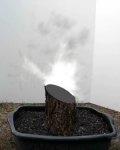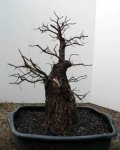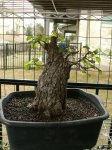In order to really determine if this particular "technique" has worth, we need to actually attempt to quantify value. The best way that I can think of to do that is to compare this technique to a more traditional technique for developing taper and evaluate the various differences in each method.
If one were to develop this same tree using a more traditional approach, the following steps would need to be taken:
Step One: The tree would have to be chopped at a relatively low point in order for taper to begin at the same point as in the existing version of the tree. This would look something like the image below. After the chop, of course, the tree would need to be left to grow for a number of years in order for the new leader to reach the thickness of the existing tree. I imagine a low estimate would be about 5 more years, but I suspect it could take even a bit longer.

After that period of growth, the tree would need to be chopped again. At this point, our theoretical tree has reached about the same height as the actual tree, and will need to continue to be allowed to grow freely to remove the appearance of the chop and continue developing taper.

This isn't really a step, but the point at which the tree will have caught up to the development of the actual tree. After maybe three years of growth after the second chop, the tree will have developed branching approximately equivalent to the size of the tree currently. If the tree is to be developed with no visible scars, it will have to continue to grow for another (I suppose) three or four years to allow cambium to grow over the wound and then possibly be chopped again. Otherwise, carving could be done to develop hollows or other deadwood features.

My estimate for the total time for development up to the point of step three is about eight years, and I think that's conservative.
Now let's compare that to Dario's work, which actually took only two years (the picture below was taken in February of 2014). If the intention is to completely eliminate the appearance of any carving or cutting on the trunk, the tree will probably need to grow freely for another three or four years. Otherwise, he could possibly begin carving this year.

Now let's do a quantitative comparison, so we can actually see a little more clearly how the two methods compare. I like to use a pro's vs. con's comparison for things like this.
"Dario's Method"
Pro's
Development period is shorter by 4 to 5 years (or more)
Original, developed bark is kept on a greater surface area of the trunk
Con's
The two sections of the trunk that were pressed together may not achieve full cambium fusion
Getting cambium to completely cover over the open area may be challenging
Traditional Method
Pro's
Tested and proven method for developing taper and healing over chop wounds
Trunk will be in one solid piece
Con's
Some of the original bark will be lost in the upper portion of the trunk
Quantifying
After the pro's and con's have been listed, some sort of value needs to be assigned to each one so that we can determine the weight of each factor. This is where things get tricky. Things like faster development may be more or less important to different people. Let's assume for simplicity's sake that each year in development acts as a negative score of 1. So that neither method falls into a negative score due to years in development, I'll start each method out with a positive score of 10.
Here's how I might score each method:
"Dario's Method"
Starting with a positive score of
10 points.
Years in development (up to current point): 2 ;
points: -2
Original bark is kept on greater surface area (pro) -
points: +2
The two sections of the trunk that were pressed together may not achieve full cambium fusion -
points: -1
Getting cambium to completely cover over the open area may be challenging -
points: -1
The final score for this method is
8.
I personally think that the cambium does have a chance of fusing together, and because this is something that is just a possibility and not a certainty one way or the other, I've only given this a value of -1. I have the same thoughts regarding the chances of the chop wound being covered over. I think if it's possible that an equally large wound could be healed over using a traditional chop method, the chances of this wound healing over, despite the unusual shape, are still considerably high. In addition, I am thinking here about the method itself, not this particular tree. Even if Dario is not successful in getting the wound to heal over on this particular tree, I do still believe that, if executed well, wounds and chops could be made to heal over convincingly using this method.
Traditional Method
Starting with a positive score of
10 points.
Years in development (up to current point): 8 :
-8 points
Tested and proven method for developing taper and healing over chop wounds:
+1 point
Trunk will be in one solid piece:
+1 point
Some of the original bark will be lost in the upper portion of the trunk:
-1 point
The final score for this method is
3.
Of course, we know that the traditional method works. It is reliable and proven. When we have larger trees, it may take some extra time to develop appropriate taper, but it certainly does work.
Now, let's say that number of years in development isn't really significant. We have plenty of time to develop a good tree. If we completely remove the significance of the number of years in development, we get slightly different scores:
Dario's Method:
10 points
Traditional Method:
11 points
Note, though, that the reasons for Dario's method's loss of points and the traditional method's higher points are merely factors of certainty and uncertainty. We are uncertain of the ability for the method Dario used to result in a whole, un-scarred trunk. We are certain that the traditional method can, when done well, produce a relatively un-scarred trunk. If we find that, using the method that Dario has attempted, a relatively un-scarred trunk can be produced, then these factors can be removed.
Hopefully this attempt at an analytical comparison can help some determine whether this method might be useful for themselves. Feel free to change the values based on your own opinion of the importance of each factor and add/remove pro's and con's to determine what works best for yourself.





